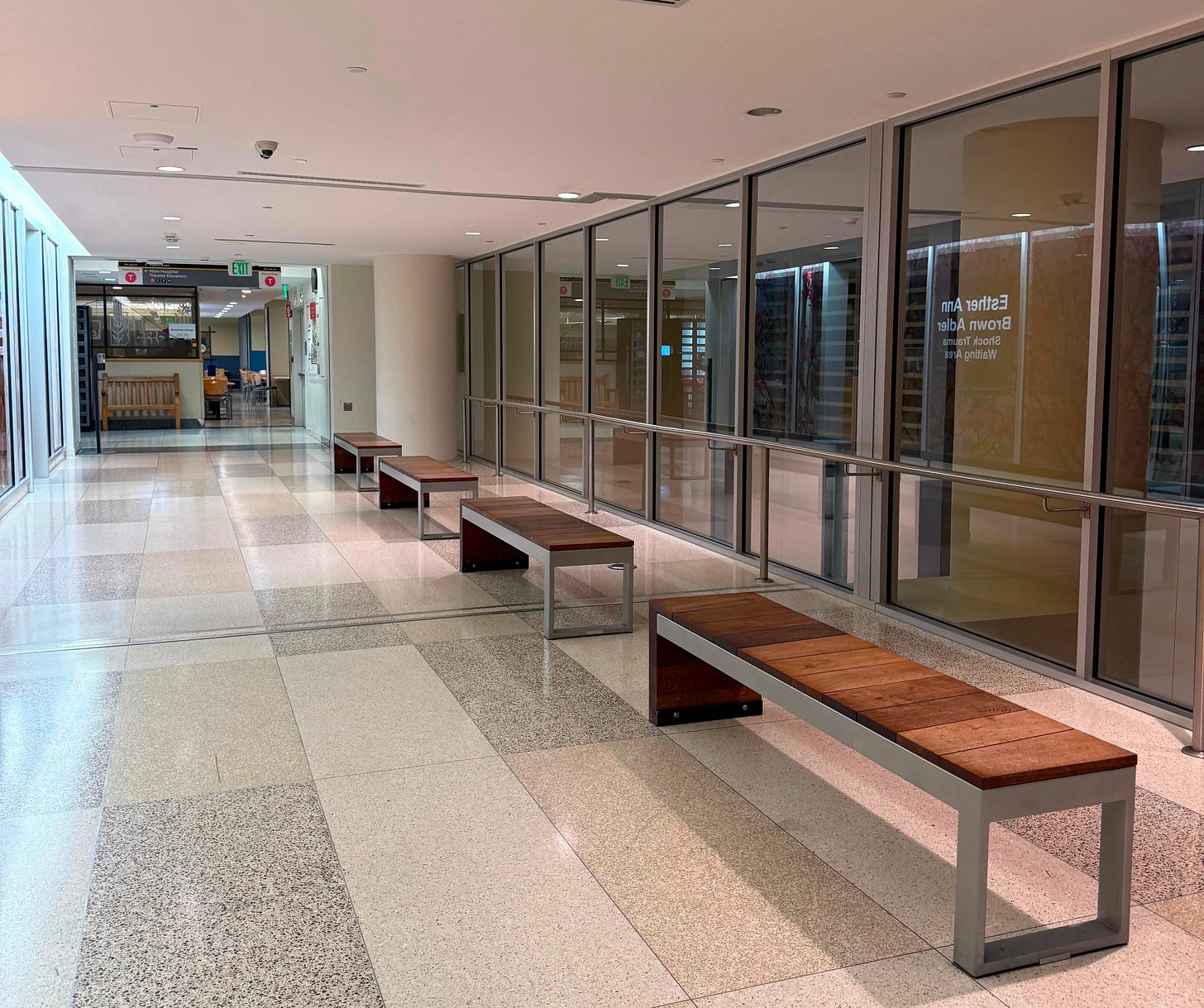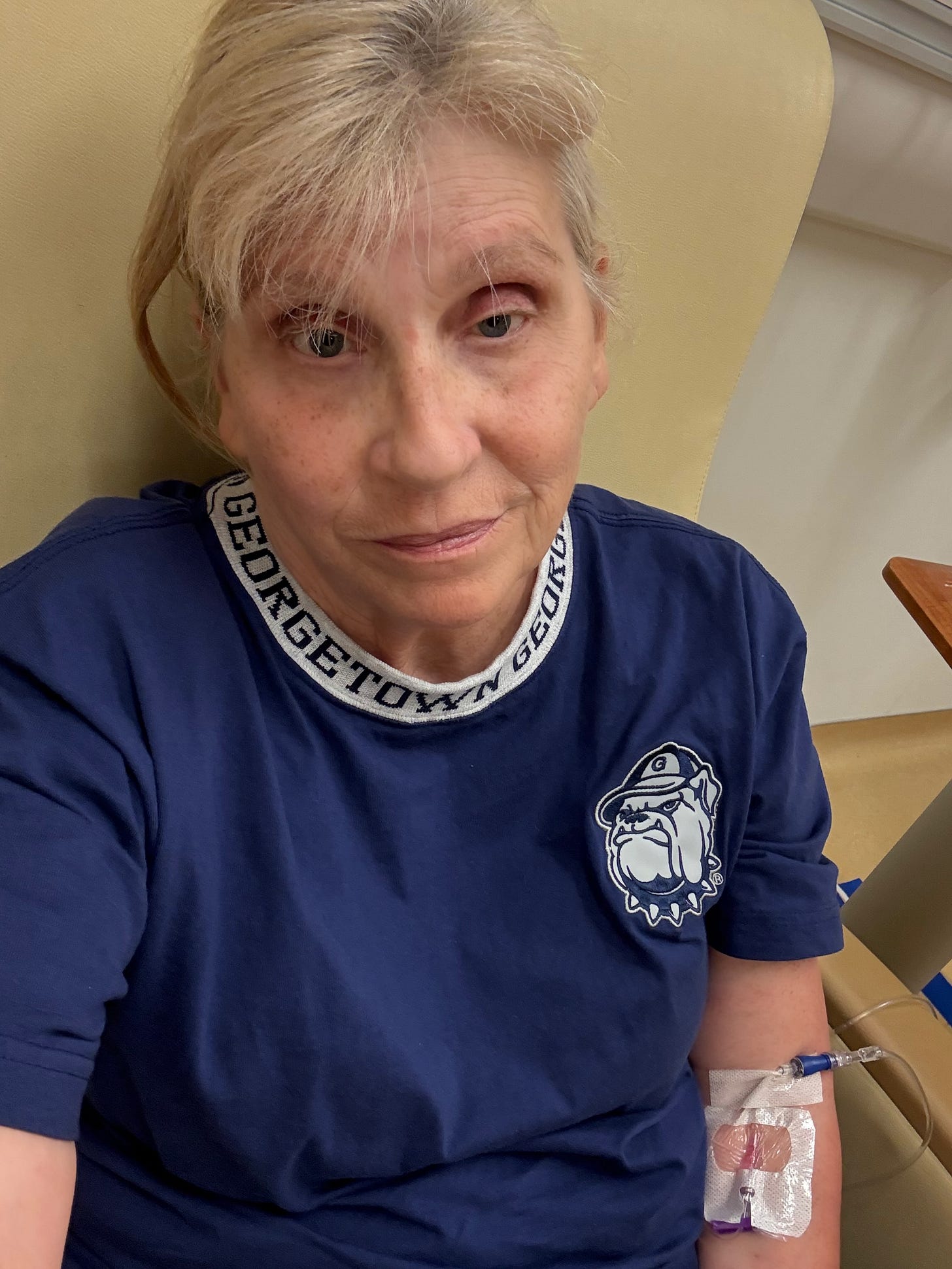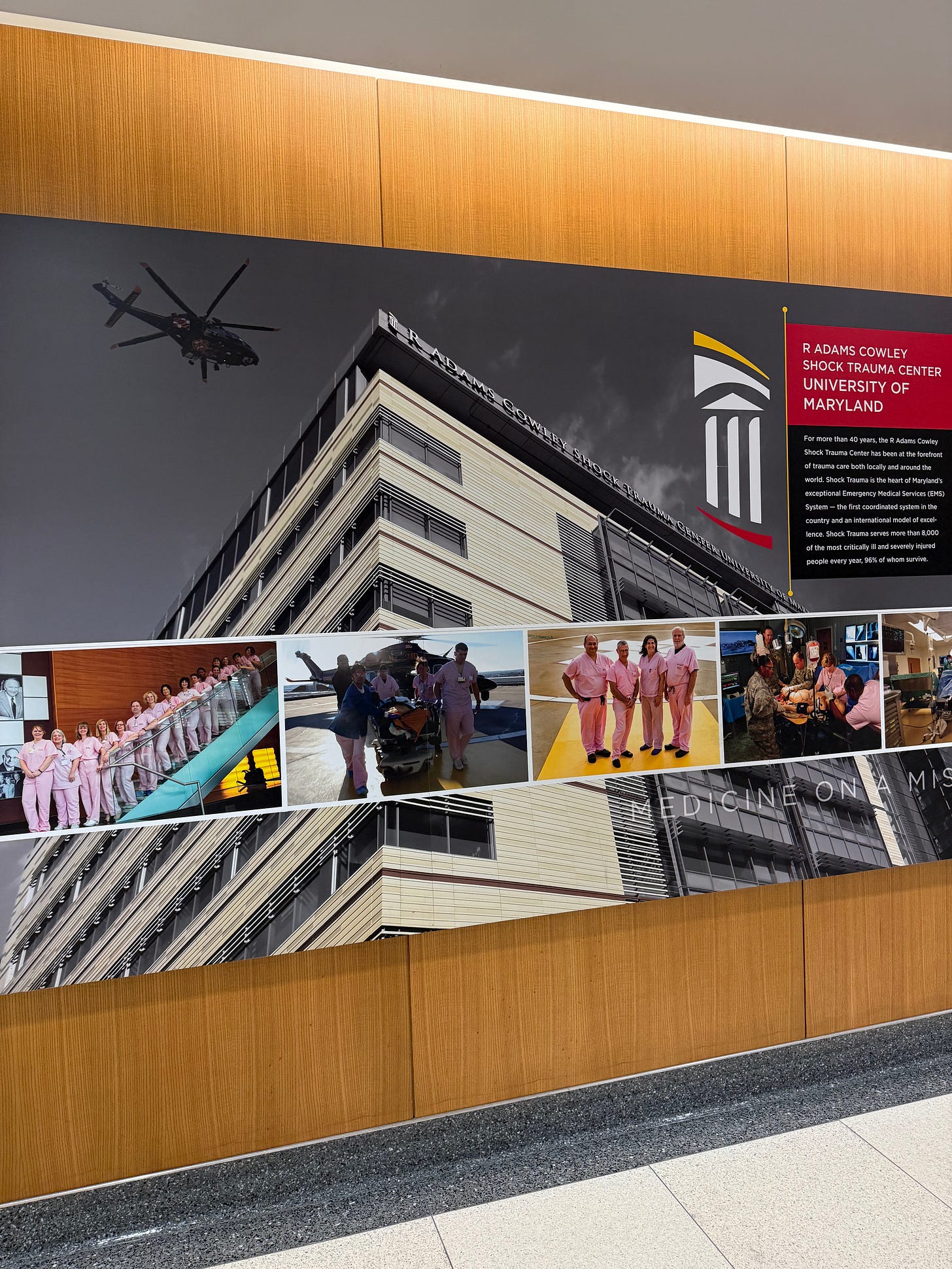Tip Toeing through the Echoes of a Medical Trauma
Dental complications bring back memories of a helicopter ride and near death experience
It was 4am when I suddenly realized I was padding softly in my soft-soled moccasins through a familiar and eerily quiet hallway, dimly lit at this hour, only me and a lone building service worker pushing a trash cart.
Long benches came into view, planted in front of floor to ceiling windows that illuminated the outside lights piercing the darkness of the wee hour. I walked along the speckled stone tile floor, when it hit me that I was walking through the same hallway where I had filmed a sepsis segment for WBAL-11 news in September 2023. I was in Shock Trauma at the University of Maryland Medical Center in Baltimore! The place where I almost died, and my life was saved, 4 years ago.
My husband drove me to the emergency room that night at the behest of Dr. L., the maxillofacial surgical resident on call. I have been a patient at the University of Maryland School of Dentistry for the past two years and undergoing bone graft and dental implant procedures since last August. I’m what my doctors call a “complex” patient, a “diva” jokingly by some, but without a doubt, nothing ever goes easy for me medically. We arrived in the emergency room around midnight, right next-door to the infamous Shock Trauma, which had almost been my final destination once upon a disastrous day in May. The nurses in the emergency department were wonderful, capable, and soothing, the place was calm, clean, and quiet, as far as big-city emergency rooms go. We appeared to be the only ones in the dimly lit waiting area. We heard the murmuring voices of a few young mothers who came in and approached the registration desk with sick babies with fever and coughs. I watched from my seat as they registered their little ones, and the nurses gently popped on the wrist bands. I remembered bringing my own little ones into emergency rooms so very long ago.
I was brought into triage almost immediately. The resident had called ahead, like calling in an Uber-eats order. I didn’t even have time to glance at my phone. The nurse was kind and compassionate. I was suffering the most extraordinary facial pain of my life, and my body, being disabled, chronically ill, having given birth, and suffered septic shock, was no stranger to pain. I was a “hold my beer” kind of person when it came to pain. The region around my recent dental implant/bone graft surgery, was pulsating with a stabbing pain, tingling and numbing my lower lip, spreading into my left ear and making my left eyeball feel like it was bleeding out. The pain was pissing off all the neighboring teeth on the right side of my lower and upper jaw. I had endured this 10/10 level pain for more than 48 hours, hadn’t slept, and was beside myself, texting first my endo (oral surgeon) student who had performed the procedure, but it being Memorial Day, there wasn’t much he could realistically do over the phone, he said he’d get me into the clinic as soon as possible.
My husband and youngest daughter were ready to haul me off to an emergency room at that point, any emergency room, as it was nearing 10 o’clock and I was in tears. The pain wasn’t letting me sleep, eat, drink, or talk. Any movement on my behalf sent me up the wall. I wanted to ransack our toolbox, grab a set of pliers and yank the offending teeth myself, or swallow a handful of my husband’s Prednisone, a powerful steroid. And I hate steroids. It occurred to me to call the University of Maryland Emergency Department and ask them to page the dental school resident on call. It worked! The staff member who answered the call was very sympathetic and said she’d put in the page. Dr. L. called me right away, asked what was going on, type of pain, how long, all that good important stuff, and instructed me to head to the ER and tell the staff to let him know when I checked in. I made him aware that I was a septic shock survivor. Four years ago, my colon perforated from undiagnosed diverticulitis, and I went into septic shock which caused lung and heart failure. I was placed on a ventilator and flown 75 miles by helicopter to the ominous Shock Trauma building, a top tier trauma center in the DMV whose walls and staff had witnessed some of life’s worst medical maladies. Life saving surgery performed by a gifted colorectal surgical team brought me back from the brink when physicians didn’t expect me, a 58-year-old with multiple comorbidities, clinging to life, to survive. Ever since they saved my life, I hold a reverence and deep respect for Shock Trauma, and the medical providers and staff who work within those walls. I felt “at home” here, “safe” here. I felt like the providers cradled me metaphorically in their arms as they cared for my medical needs following my life-threatening event. And most have a great sense of humor, which I direly need as a patient who is a “frequent flyer” needing medical care. They were also sensitive to my sepsis PTSD medical trauma. They checked all my boxes as a “dream provider.” Like the old “Mystery Date” game, you either got the “hunk” of a doctor, or the “dud.” I’d had my share of “duds” through the decades, and my current teams are like a match made in Heaven.
After I was triaged I was taken to the back where patients were awaiting treatment. It was very quiet and calm back here too. Nurses whispering at the desk, patients moving subtly in beds behind curtains. I sat in a chair while they called Dr. L. and took my vitals. The nurses back here were also exceptionally kind. Smiling and looking at me with empathetic faces, making small talk while they expressed genuine concern for my excruciating pain. The triage nurse revealed to me that she had had dental implants years ago and suffered some complications. She looked at me with knowing eyes, and said, “I know what you’re feeling.” My lovely nurse, in the back, taking my vitals, said she would need an implant, and now she was a little scared seeing the pain I was going through. I told her not to worry, to absolutely do it. She was young. I was old, with many things falling apart. I have small fiber neuropathy, for one, which both my endo student and the resident suspected was behind my searing, now burning pain in half my face. I also have Crohn’s Disease, hypermobile Ehlers-Danlos Syndrome, and POTS. Oh! And osteoporosis, can’t forget that one, my previously fractured spine, wrist and shins, never let me forget.
Dr. L. came down and could tell by looking at my face that I was DONE. 100 percent stick a fork in me done, and living a pain infused nightmare in my face and jaw. He asked me about the pain, like he did on the phone. He shined a light in my mouth and said it didn’t look like an infection. Thank God!
I followed him upstairs so he could do a panoramic x-ray. As we walked through the dimly lit, empty hallways, I felt a calming peace, despite the pounding pain. We looked at the x-ray image and admired Dr. M’s work, my student endo. Truly a gifted oral surgeon-in-the-making. The implant screws looked great, and, as University of Maryland doctors often do, Dr. L. explained what he was seeing on the x-ray, no signs of infection. I love how they “teach” us patients, a benefit of going to a university hospital. We went back to the ER patient care area, where he decided it HAD to be my small fiber neuropathy causing all the ruckus. The implant screw didn’t appear to be anywhere near the nerve, but small fiber neuropathy is a fickle beast and can get irritated just by the vibration of the drill in the construction area. He prescribed one of the only strong narcotics that I wasn’t allergic to - dilaudid. And IV fluids, since I was unable to drink my Liquid IV infused water for several hours, and my remaining half a colon that was resected four years ago during my sepsis crisis, didn’t like it when the well ran dry in there. He also suggested a 10 mg Prednisone. I was wary of steroids ever since my sepsis crisis, I was on high doses of Prednisone back then. He reassured me it was only short term, a couple pills, and that was it. So I relented and my internal alarm bells that screamed STEROIDS - warning! warning! Will Robinson! shrank back into hibernation mode.
The first dilaudid pill didn’t work. At all. I was sat in a comfortable lounge chair and the nurse slipped in the IV and gave me the tiny magic pill which was supposed to bring oh-so-sweet relief, but failed to produce any magic whatsoever to beat the monstrous pain. I had taken the Prednisone too. Nothing. So when she checked on me in half an hour, she could tell the magic pain-relieving pill wasn’t working. She gave me one more, and about 15 minutes in, I finally started to feel the pain stand down. It melted away from my eye and ear first, and then slowly receded across my jaw like an outgoing tide.
I could actually check my phone to see where my husband was, in the parked car, tucked in for a nap while I was being treated, as he wasn’t allowed to come back in the patient area. He had texted me to call and wake him when I was done. It was nearly 3 am. I snapped a photo and let my lovely Instagram followers know that I was “okay” and on the mend. I love my followers. I don’t have a huge following, but that’s not the point, I have a community of loving, funny, and caring individuals to share the trials and tribulations of being a disabled chronic illness patient, some of us who also kicked sepsis ass. The nurse came in and was happy I’d gotten some relief. She undid the IV, slipping it out as painlessly as she had placed it and went over my discharge papers, with the ever-so-cautious warning to come back if fever came on or the pain returned. No more helicopter rides into Shock Trauma, please. I reassured her about the implant procedures, and urged her to try. The ER was still relatively silent, with a few nurses tending to patients and talking quietly. I had a prescription to fill and feeling so much better now, and pain-free, I headed up to the 1st floor where the 24/7 pharmacy was located. It was like a vice had been removed from my jaw.
It was still very quiet, a security guard guided me to the correct elevator. I felt like “When have I been here before?” I went up one floor and came into what I could feel was a familiar aura washing over me. A dimly lit hallway, and then I saw the bricks of the orginal hospital building, on the inside now enveloped by the new building.
I remembered that my room during my septic shock stay, was up there, somewhere. I gazed upward for a second, before continuing down the hall. I saw the building services worker and asked if I was heading in the right direction to the pharmacy. He indicated that I was.
And then I saw it. The Shock Trauma waiting room on my left, a lone person slumped in a chair appeared to be sleeping, and then the benches and windows on my right. And then it hit me! I was inside the Shock Trauma building itself! I recalled the segment we filmed for Sepsis Awareness Month two years ago, right here in these very halls. The cameraman and the fabulous Jennifer Franciotti asked me to walk down the hallway, and then sit on one of the benches. It was a thought provoking segment. This hallway and that waiting room, felt “hallowed” to me. They had witnessed the anguished cries of family members who had just received the worst news possible of their lives, and the joy and triumph of those who survived. Life, I believe, is random. There’s no “reason” I’m still here. If there is, what does that say about those who aren’t? They were just as valuable, especially to their families. No. I’m just here, because. Because life is random like that. A newly installed “Survivor Wall” described the triumphs and wins of those who made it. I paused to read some of it, and decided I’d look into the in-person peer support groups, because sepsis has left me with some interesting baggage I have yet to fully address.
It felt like walking through the echoes of my sepsis trauma. Silently, stealthy, tip toeing as though not to re-awaken the trauma. And then I stood very still in the empty hallway to absorb it, experience it, and feel it, almost in disbelief that I was standing on two feet in the hallway, instead of being upstairs in the SICU struggling to recover from the septic devastation, almost exactly four years ago from that night. And then a bit of something else washed over me. Survivors’ guilt seeped in. As a sepsis advocate, I know far too many families who weren’t as lucky as mine. Who had lost a beloved to sepsis. My heart breaks into a million jagged pieces whenever I think of them. The babies, children, young adults, parents, siblings, grandparents. All of them. All 350,000 of them, who lose their lives to sepsis every year in the U.S. And the 6,800 children. The weight of their family’s sorrows never forgotten. With a heavy heart, I solemnly pushed on through the hallway to the pharmacy. Another smiling staff member delivered my medications, tucked neatly inside a white bag, and wished me well.
I walked back down the dim hallway. Still the only one there. It was nearing 4am. I treaded carefully, quietly, still mulling over my thoughts. Imagining the helicopter (which I thankfully don’t remember) and a re-enactment upstairs in pre-op, of what I had read in my medical notes, which still gives me chills and a sickening gut punch in my stomach. I stopped and turned, and cast one last glance down the hallway, my heart filled with gratitude for all the healthcare heroes who work there. Who witness the worst of the worst every single day, and still show up for more patients the next day. And then I made my way to the front entrance where my husband was waiting to collect me after my harrowing pain-filled ordeal. I slipped inside our car, leaving the echoes to remain, until I happen upon them another day. Unafraid (for now), and forever changed by sepsis.








Great job, Jackie. What a harrowing story with the dental implant and the trauma trigger from the shock center. I’m grateful you’re ok and look forward to reading more. 🌺